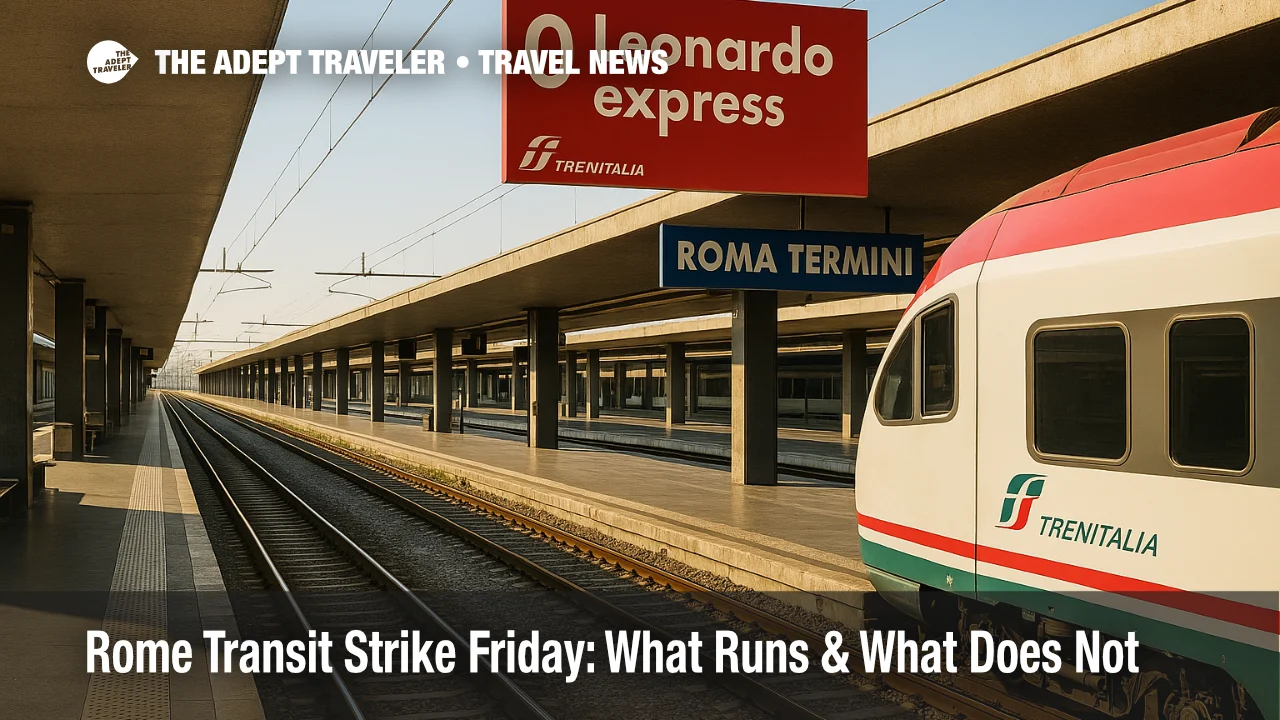Rome transit strike Friday: What runs and what does not

A 24-hour ATAC walkout will disrupt Rome's local transit on Friday, October 10. Metro lines A, B/B1, and C, plus buses, trolleybuses, trams, and the Termini-Centocelle rail are subject to stoppages outside Italy's legally protected time bands. Trenitalia regional and airport trains, and Cotral regional buses, are expected to operate normally. Travelers connecting to Rome Fiumicino Airport (FCO) can avoid the worst of the strike by using the Leonardo Express or FL1 trains, or licensed taxis, instead of relying on ATAC buses and metro lines.
Key points
- Why it matters: Core metro, bus, and tram services face all-day slowdowns outside protected hours.
- Travel impact: Expect crowding, longer waits, and possible metro gate closures mid-day and late evening.
- What's next: ATAC will post day-of updates; riders should refresh advisories before heading out.
- Guaranteed service windows: Start of daytime service-829 a.m., and 500-7:59 p.m.
- Air-rail alternative: Leonardo Express Termini-FCO in 32 minutes; FL1 serves Tiburtina-FCO.
Snapshot
ATAC confirms that service is guaranteed during the "fasce di garanzia" from the start of daytime operations to 829 a.m., and again from 500 to 7:59 p.m. Outside those windows, riders should anticipate reduced frequencies or suspended trips on metro lines A, B/B1, and C, surface buses and trolleybuses, trams, and the Termini-Centocelle rail. Roma Servizi per la Mobilità notes that regional providers Cotral and Trenitalia will run as scheduled, which preserves direct airport links. For Rome Fiumicino Airport (FCO), Trenitalia's Leonardo Express offers a non-stop 32-minute ride from Roma Termini, while the FL1 regional line connects Roma Tiburtina to FCO in about 48 minutes with frequent departures on working days.
Background
Labor actions on Rome's local network typically follow a predictable pattern: guaranteed peaks for commuting, with service at risk between the peaks and after 8:00 p.m. Friday's strike fits that template. ATAC's advisory covers its entire urban network, including substitute bus services for any affected tram routes. Roma Servizi per la Mobilità underscores that guarantees apply only within the legally mandated bands and that service quality outside them depends on staffing levels. Because the airport links are operated by Trenitalia and not ATAC, they are insulated from the local action. This makes rail the most reliable strategy for airport transfers during the walkout. Travelers should still allow extra time at stations for crowding, ticket purchase, and platform access.
Latest developments
What runs during the Rome transit strike and how to reach the airport
ATAC's guarantee bands hold service steady from the start of daytime operations until 829 a.m., and again from 500 to 759 p.m. Between 830 a.m. and 459 p.m., and from 800 p.m. to end of service, riders may see thinning frequencies, curtailed routes, and intermittent metro closures for safety if staffing falls short. Cotral regional buses and Trenitalia trains, including airport services, are scheduled to run as normal. To reach Rome Fiumicino Airport (FCO) from Roma Termini, the Leonardo Express runs non-stop in 32 minutes with departures about every 15 minutes. From Roma Tiburtina, the FL1 regional line reaches FCO in roughly 48 minutes, with typical working-day headways of about 15 minutes. Licensed taxis at FCO's official ranks remain a fallback if rail crowds are heavy. For broader October labor context, see our primer: Italy transport strikes: October protests and walkouts that affect travel.
Analysis
Friday's Rome transit strike presents a classic split between municipal operations and regional or national rail. Because ATAC controls the metro, buses, trams, and the Termini-Centocelle line, any staffing shortfall hits the city network hardest outside the peaks. The guaranteed windows should move commuters, but mid-day and late evening will feel the squeeze. Crowd management at major stations may trigger temporary gate holds to prevent platform overloads, particularly on Metro A and B interchanges. By contrast, Trenitalia's airport products sit outside the local action. Leonardo Express is purpose-built for Termini-FCO links and keeps airport-bound travelers off the metro entirely. The FL1 corridor gives Tiburtina and key suburban stops a direct tie to the airport that bypasses ATAC. Given these dynamics, the most resilient plan is rail-first: buy tickets in advance where possible, target departures within the guarantee bands when connecting across modes, and budget 20-30 extra minutes for station flows and crowds.
Final thoughts
Use the protected time bands to your advantage. If you must cross town on metro or tram, aim for before 830 a.m. or between 500 and 8:00 p.m., and be ready to walk a stop or two if surface routes thin out. For airport runs, prioritize Leonardo Express from Termini or FL1 from Tiburtina to keep your itinerary intact. Licensed taxis at official ranks provide a workable back-up if platforms are jammed. With a rail-first plan and a little buffer time, most travelers can sidestep the worst of the disruptions during the Rome transit strike.
